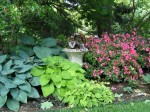
Not all shade is created equal. The amount of light is not the only factor to consider; the time of day the shade occurs is also an important consideration in choosing plants for a shady area. In addition, the amount of shade in an area will vary with the time of year so watch your shaded area carefully over a long period of time. I have identified 6 kinds of shade.
Dense shade: This area gets no direct sunlight at all. It is usually very dry or very wet depending on whether water can reach it. Dry shade is the most difficult to deal with since plants need both light and water. If you are willing to water the area there are plants that will do well such as Japanese aucuba, some ferns and ivies, and liropes. You could also pot sink houseplants or seasonal plants while they are in bloom. If a water supply is not possible mulch the area with something attractive and add some garden ornaments like statuary, large rocks or a bench.
Dappled/Filtered Shade
This area gets shade from morning to night but in small doses. It is usually found under a large open branched tree or a structure with lathe or shade cloth. All shade plants love it because they have plenty of light but don’t burn in the heat of the sun. This is the place to plant azaleas, camellias, all ferns, impatiens, many hostas and coleus.
Afternoon shade
This area gets the cool morning sun but afternoon shade due to a structure or other plants. The east side of a house, a tree, or even a pot can create afternoon shade. All shade plants love this kind of shade because they have full light for about half the day without burning and then be shaded from the heat of the afternoon sun. Plants that will do well here include mahonia, Japanese privet, euonymus, daylilies, bergenia, impatiens, many hostas, begonias, coleus, geraniums (pelargoniaums) and hydrangeas.
Morning shade
This area has shade in the morning until about noon and then has to face the hot sun all afternoon. The west side of a structure or plant can create this kind of shade. The plants in this area will be especially stressed if they do not have adequate water. Shade plants will not do well in this area so choose plants that can tolerate sun and shade such as nandina, India hawthorn, daylilies, geraniums (pelargoniums), and begonias.
Bright shade
This area gets no direct sun but is light all day. It is the kind of shade that is found in a northern exposure of a house or under a high limbed deciduous tree. Some plants that do well if the area has sufficient water ostrich fern, astilbe, perennial foxglove, hosta, hellebore, Virginia bluebells, and Toad lily.
Bipolar shade.
This area is shade until mid morning and again from mid afternoon onward. It has sun from about 10:30 to 2:30 which is hard on the plants because of the heat and intensity of the sun but is not enough sun for the sun loving plants. This is a very difficult area to make into a garden. Try tough plants like nandina, acuba, daylilies and coneflowers.
You probably are only interested in the sun and shade during the spring and summer months but if you plan to have winter blooming plants notice that the shade situation may be different in the winter and places you thought were shade are now in the sun. This is especially true of a northern exposure that may have dense shade in the summer but sun in the winter. Plants that can grow in this situation include camellias, azaleas, many ferns, and Japanese maple.

[…] recognize all its different kinds, and see it as many opportunities, rather than as a problem. Evaluate the shade in various parts of the garden and rocognize the different niches that exist. 2. Plan the garden so […]
[…] situation first remembering that you can move the containers around to catch the sun if necessary. Evaluate your shade as not all shade is the same and all vegetables will need some light. There are vegetables that […]
[…] have high light needs but many other beautiful plants love afternoon shade. You need to carefully evaluate your shade and plan accordingly. You have to make sure that they are getting adequate water (1” per week is […]